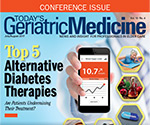 |
Researchers have found that the hormone glucagonlike peptide-1 (GLP-1) binds to its receptor on the outside of a cell, which causes changes to the arrangement of the part extending into the cell. GLP-1 plays an important role in regulating insulin secretion, carbohydrate metabolism, and appetite. Identifying a key cellular receptor for diabetes may ultimately result in new drugs for diabetes treatment.
In addition to reading our e-newsletter, be sure to visit Today’s Geriatric Medicine’s website at www.TodaysGeriatricMedicine.com, where you’ll find news and information that’s relevant and reliable. We welcome your feedback at TGMeditor@gvpub.com. Follow Today’s Geriatric Medicine on Facebook and Twitter, too.
— Barbara Worthington, editor |
 |
 |
First Snapshot of Diabetes Receptor May Mean New Drugs
Researchers have captured the first cryo-electron microscopy (cryo-EM) images of a key cellular receptor for diabetes in action.
The findings, published in Nature, reveal new information about the workings of G protein-coupled receptors (GPCRs), which are intermediaries for molecular messages related to nearly every function within the human body.
GPCRs reside in cell membranes, where they detect signals from outside the cell and convey them to the inside to be acted upon. They respond to signals including sensory input such as light, taste, and smell, as well as to hormones and neurotransmitters.
The new near atomic-resolution images provide an incredibly detailed look at how these important receptors bind to and transmit signals from peptide hormones.
The team revealed how the hormone glucagonlike peptide-1 (GLP-1) binds to its receptor on the outside of a cell and how this causes changes to the arrangement of the part extending into the cell, which then engages and activates the G protein.
Full story » |
 |
 |
Bugs and Bones: Connecting Gut Bacteria and Bone Health
Experiments in mice have found that gut microbiota regulate bone mass. Modification of these microbiota with probiotic supplementation showed a beneficial effect on general bone health under nondiseased conditions and reduced bone loss in estrogen-deficient mice. Read more »
Lifespan Planning Promotes Successful Aging in Place
Providers should encourage elder patients to develop action plans to address unforeseen eventualities such as falls and hospitalizations that threaten independence. Communicating these plans can enhance patients’ opportunities to remain in their homes and connect with community-based resources. Read more »
Telehealth: An Untapped Opportunity for Nursing Facilities
Telehealth can be a significant untapped resource for subacute and long term care facilities, allowing them to provide higher quality care for older adults at lower costs. Read more » |
 |
 |
Fuel Your Drive for Diabetes Education at AADE17
By Heather Hogstrom
Known as the racing capital of the world, Indianapolis is home to the Indianapolis Motor Speedway, which hosts the Indianapolis 500 and NASCAR’s Brickyard 400, and features the Auto Racing Hall of Fame. This city will also host the American Association of Diabetes Educators (AADE) 2017 Annual Meeting, where attendees can rev up their passion for diabetes education. Scheduled for August 4–7, the conference revolves around the theme “Keep Your Drive Alive” and emphasizes driving change and innovation.
Attendees can learn about the latest diabetes technologies, products, services, medications, foods, and more in the exhibit hall, product theaters, and educational sessions. The sessions, which are grouped into six education tracks, cover a wide range of topics. Sessions particularly relevant to those in geriatrics care include “Seniors With Diabetes: Why Are They Different?”; “Different Generations, Different Strategies: A Workshop in Customizing DSME”; and “Self-Monitoring of Blood Glucose for Older Adults: Hazards and Strategies.”
Full story » |
 |
|
|
 |
The Bug Problem in Nursing Homes
Elderly nursing home residents are particularly vulnerable to drug-resistant infections, according to an article in The Wall Street Journal. And antibiotic overuse is the source of the problem.
Ear Rocks: A Common and Fixable Cause of Vertigo
An article in The Philadelphia Inquirer explains that older adults’ disturbing bouts of dizziness may be caused by benign paroxysmal positional vertigo that results from the misplacement of ear crystals. The condition can be remedied via the Epley maneuver that repositions the crystals.
Walking Has Benefits for Dementia
One-hour walks three times per week can have beneficial effects for older adults with early vascular cognitive dementia, according to an article in The New York Times.
New Vancomycin Kills Antibiotic-Resistant Bacterial Superbugs
According to an article in The San Diego Union-Tribune, a reengineered version of vancomycin may possibly overcome the resistance of bacterial superbugs. |
 |
 |
GeoPendant
RCare has incorporated a new “safe zone” feature into its nurse call line. The GeoPendant allows users to designate safe perimeter areas for residents and receive an alert if a person presses the button or leaves the safe zone. It can reduce loud or noisy alarms and is particularly useful in mixed resident populations. Learn more »
Reminder Rosie
Reminder Rosie provides a simple hands-free solution to help patients remember their medication, appointments, and other tasks without touching any buttons. Easy to use and set up, Reminder Rosie is a clock that plugs into a wall outlet for power; battery backup retains the clock time and alarm settings even during a power outage. The familiar-looking LED clock records and plays personalized voice reminders at any time in any language. It provides a loud alarm and large display. Hearing a loved one’s voice routinely has shown to deliver ongoing compliance with medications and treatments. Users can benefit from greater independence and safety. Learn more » |
 |
 |
 |
A Secure, Anonymous Résumé Bank
Job Alerts Sent to Your E-mail |
 |
|
